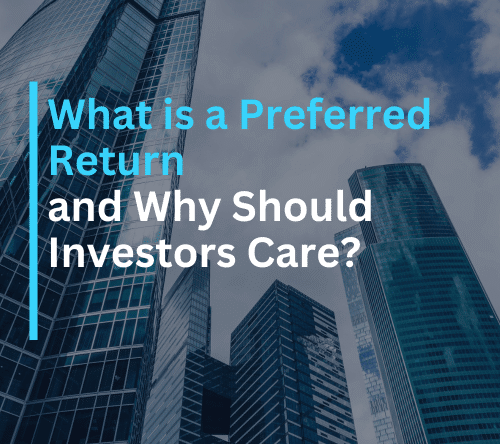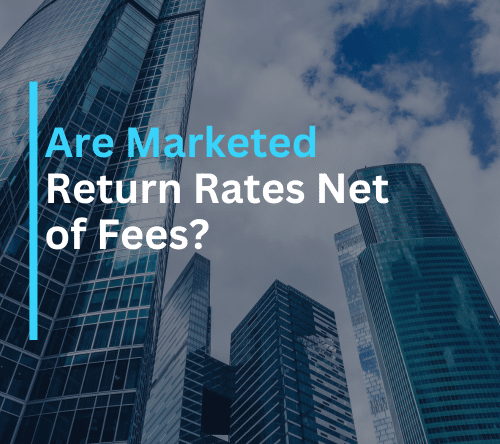If you are trusting an investment sponsor with your capital, you want some kind of assurance that you’ll receive a certain level of returns, right? That’s where a preferred return comes into play.
A preferred return, or “pref,” is a mechanism often used in real estate, private equity, and other alternative investments to prioritize investor payouts. Understanding how a preferred return works—and why it matters—can help investors make informed decisions about where to place their capital and how to assess potential risks and rewards.
What is a Preferred Return?
A preferred return is essentially a minimum rate of return that investors are promised before any profits are distributed to the sponsors or general partners. This is an investor-friendly arrangement, as it prioritizes initial distributions to investors up to a certain rate (often between 6-10%, depending on the deal structure), ensuring they receive a predictable return before other profit-sharing arrangements kick in.
Let’s say you invest $100,000 in a real estate syndication with an 8% preferred return. This means that each year, the first 8% (or $8,000) of returns generated by the project goes directly to you and any other investors before the general partner team receives a payout. Only after meeting this preferred return threshold does the sponsor or general partner start to receive any portion of the profits.
A preferred return does not mean that your returns are limited or capped by that percentage. Depending on the deal’s structure, investors in syndications can earn much more than their preferred return. The pref is merely a mechanism to protect passive investors’ minimum return rates.
Why is a Preferred Return Important for Investors?
Preferred returns can be very appealing for investors for a few reasons:
Priority in Returns
The preferred return structure gives investors an added layer of financial security. Knowing that they’ll be first in line for profits before the sponsor gets paid aligns the sponsor’s incentives with their own, building trust and promoting transparency.Risk Mitigation
When investing, risk is a given. However, preferred returns help mitigate risk by guaranteeing investors an initial share of the returns. This structure provides a cushion, making it less likely that investors will walk away empty-handed, even if a project’s profitability is lower than expected.Building Investor Confidence
By promising a preferred return, sponsors can attract more investors, who gain confidence knowing their interests are prioritized. This structure incentivizes sponsors to perform well since they only receive their share once investors’ preferred returns have been met.
Types of Preferred Returns
Preferred returns aren’t one-size-fits-all. Here are the primary types you might encounter:
Simple vs. Compounded Preferred Return
- Simple Preferred Return: Calculated on the original investment amount only, without accounting for compounding over time.
- Compounded Preferred Return: Calculated with compounding, allowing returns to grow more quickly. For example, if you have an 8% compounded return, each year’s return builds upon the previous year’s balance.
Cumulative vs. Non-Cumulative Preferred Return
- Cumulative: If an investor’s preferred return isn’t met in a given year, the shortfall is carried forward to future years until it’s paid in full.
- Non-Cumulative: Any unpaid preferred returns are forfeited if they’re not achieved in a specific period, generally making this structure riskier for investors.
Example: Imagine a 7% cumulative preferred return. If a project only returns 5% in one year, the remaining 2% rolls forward, giving the investor a priority of 9% the following year.
Preferred Return vs. Internal Rate of Return (IRR)
It’s essential to understand how preferred returns differ from other key metrics, such as the Internal Rate of Return (IRR).
The IRR measures the overall annualized return on an investment, taking into account the timing and size of cash flows over the investment period. Unlike the preferred return, it doesn’t guarantee any specific level of payout. IRR is calculated by finding the rate (expressed as a percentage) that sets the Net Present Value (NPV) of all cash flows from an investment to zero. In simpler terms, it’s the discount rate that balances the present value of the cash inflows and outflows.
IRR helps investors assess the overall profitability of a project by taking into account the timing of cash flows, which is particularly important in long-term investments. A higher IRR generally indicates a more profitable investment.
A preferred return is a guaranteed minimum return that investors receive first, providing greater certainty.
Why Both Matter: While a preferred return guarantees investors a minimum level of returns, IRR helps investors evaluate a project’s full profitability potential. Together, they give a well-rounded view of both the safety and growth potential of an investment.
Potential Risks and Considerations
While preferred returns are investor-friendly, it’s important to consider some limitations:
- Not a Guarantee of Principal Protection
While a preferred return promises a rate of return, it doesn’t mean investors are assured full repayment of their principal. - Sponsor Performance and Economic Conditions
Preferred returns are still dependent on the project’s financial performance. If a project underperforms, preferred returns may not be fully realized. - Additional Feed anad Profit Splits
Some investment structures have other profit-sharing mechanisms or fee, which can impact the total amount investors ultimately receive. Understanding these terms, often spelled out in the operating or offering documents, is essential.
Why Investors Should Care About Preferred Returns
Preferred returns offer more than just a predictable income – they create alignment between investors and sponsors and serve as a valuable risk management tool. Here’s why they’re beneficial to consider:
- Alignment of Interests
Preferred returns align sponsors’ interests with investors’ by incentivizing the sponsor to prioritize the project’s success. Only after investors meet their preferred return do sponsors receive their share of profits. - Impact on Cash Flow
For income-focused investors, preferred returns can provide regular cash flow, a significant benefit for those looking for consistent returns. - Security in Uncertain Times
In fluctiating markets or high-risk sectors, preferred returns provide a more stable foundation, offering investors some level of downside protection and greater control ever returns.
Understanding Preferred Returns Can Make All the Difference
Preferred returns provide a level of security by prioritizing your returns over those of the sponsor, aligning incentives, and giving you confidence that your capital is working for you right from the start.
While a preferred return ensures you receive a minimum level of income, pairing this knowledge with metrics like the IRR gives you a clearer view of both guaranteed returns and overall profitabiliyu. By paying attention to both, you can make more informed decisions that better align with your financial goals and risk tolerance.
So next time you consider an investment, remember: a preferred return isn’t just a perk; it’s a valuable tool that can help maximize returns and minimize risks.




